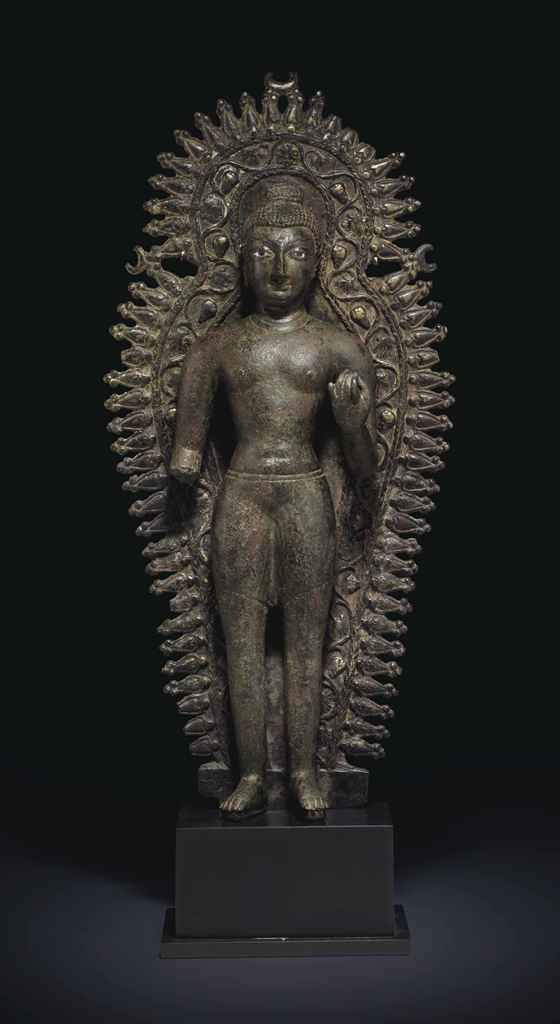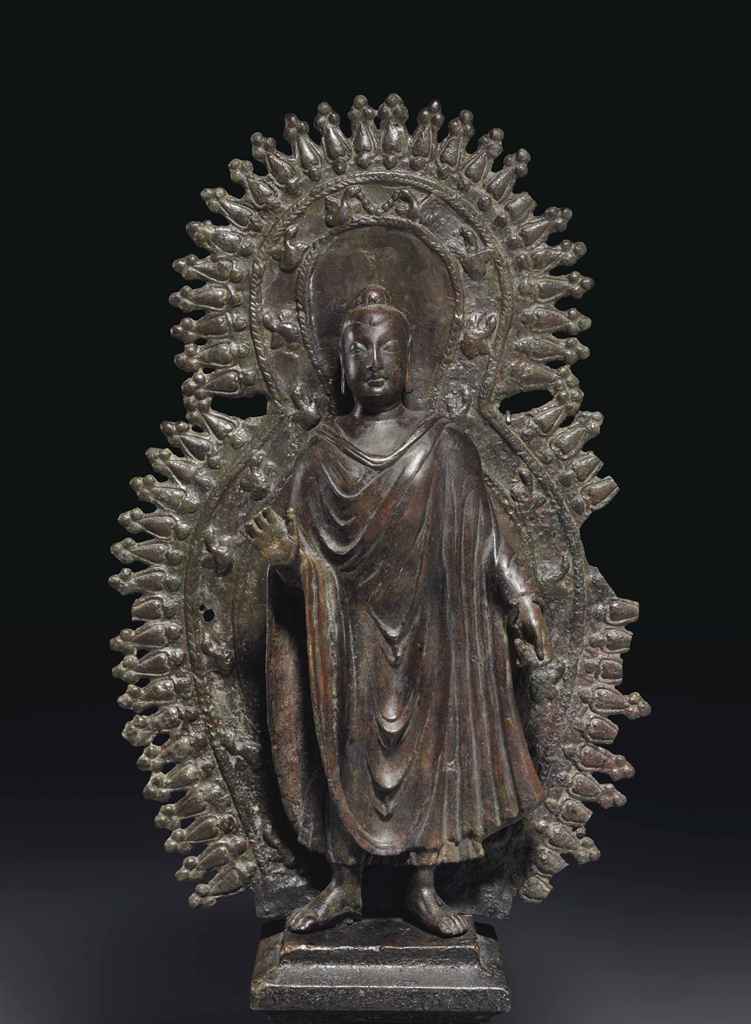HIGHLY IMPORTANT AND RARE 16TH CENTURY ITALIAN MEGILLAH AND MATCHING BLESSING SHEET, BOTH WITH COPPER ENGRAVED BORDERS BY ANDREA MARELLI Rome, circa 1570 SCROLL Megillah with illustrations printed in black on vellum, 10 membranes, 16.4 cm high, 223 cm long, 20 paired text columns of 23 lines, 9.8 cm high, blind horizontal and vertical ruling, additional blank piece of vellum joining megillah to roller 15 cm long, blessing panel 16.2 cm high, engraved frame 14.6 cm high, 20.2 cm wide, containing blessings recited before and after the megillah reading, fine Italian Hebrew square script in brown ink with taggin (crownlets). Mounted on wooden roller. CONDITION Very good to excellent overall condition, text of separate blessing sheet with minor scuffing affecting legibility of a few letters, some occasional minor fading to decorative border. THE EARLIEST MEGILLAH WITH COPPERPLATE DECORATIONS. Only two other examples of this engraved series are extant: both lack companion blessing sheet, neither in private hands. VERY LIKELY THE EARLIEST USE OF COPPERPLATE BORDERS FOR A HEBREW TEXT. THE EARLIEST SEPARATE BLESSING SHEET FROM A MEGILLAH and THE ONLY BLESSING SHEET EXTANT FROM THIS ENGRAVED SERIES. Whereabouts of a second blessing sheet from this series (published in Berlin, 1930) is unknown. ONE OF THE VERY FIRST MEGILLOT WITH DECORATION. Only one other decorated scroll (Venice, 1564; Private Collection, Israel) predates this megillah. It is hand-painted. ONLY FOUR DECORATED MEGILLOT (INCLUDING THE PRESENT SCROLL) SURVIVED FROM THE 16TH CENTURY, THE EARLIEST CENTURY OF ESTHER SCROLL ILLUMINATION. THE DECORATION AND ITS ORIGINS The megillah's twenty text columns are framed, in pairs, by an ornate copperplate border filled with delightful mannerist images. Bands of fanciful scrollwork, centered by humorous masks, surround the border on four sides, while four nude and winged putti occupy its corners. Those at top are seated on robust fruit swags, apparently plucking treats for two small birds perched upon their raised fingers. The putti of the lower corners stand beside two imposing ostriches, who, with the gentle guidance of their celestial companions, pluck fruit from the scrollwork below. This border was printed on eleven individual pieces of parchment, ten of which were sewn together to form the megillah itself. The remaining sheet provided a separate, matching blessing panel for the scroll. The exquisite copperplate border used for this scroll was executed by Andrea Marelli, a printmaker and book illustrator active in Rome circa 1567-71. While little is known about Marelli's career and oeuvre, at least four examples of his work are known today. Among them is a series of decorative frames that illuminates the history of the present Esther scroll border. Perhaps not surprisingly, this putti-filled frame, whose images bear no relationship to the Esther narrative, was not originally intended to enclose the text columns of a megillah. Rather, it was created, along with twenty-five others, to frame the twenty-six letters of a calligraphic "knot" alphabet designed by Giovanni Francesco Cresci One of the most famous Italian calligraphers of the 16th century, Cresci published this alphabet, along with Marelli's frames (some of which bear Marelli's initials or name), as part of his scribal manual Il perfetto scrittore (Rome, 1570). A copy of this extremely rare first edition, preserved in Oxford's Bodleian Library (Douce C 298), reveals that the very frame printed on the present Esther scroll appears, in its original context, around Cresci's majuscule letter "O." Marelli's frames and Cresci's knot letters were, quite significantly, the only portion of Il perfetto scrittore executed in the new and extraordinary technique of copper engraving. Only recently introduced into book illustration, this innovative technique enabled Marelli to far surpass the quality and detail exhibited in the other, woodcut, sections of the manual. Indeed, Cre
HIGHLY IMPORTANT AND RARE 16TH CENTURY ITALIAN MEGILLAH AND MATCHING BLESSING SHEET, BOTH WITH COPPER ENGRAVED BORDERS BY ANDREA MARELLI Rome, circa 1570 SCROLL Megillah with illustrations printed in black on vellum, 10 membranes, 16.4 cm high, 223 cm long, 20 paired text columns of 23 lines, 9.8 cm high, blind horizontal and vertical ruling, additional blank piece of vellum joining megillah to roller 15 cm long, blessing panel 16.2 cm high, engraved frame 14.6 cm high, 20.2 cm wide, containing blessings recited before and after the megillah reading, fine Italian Hebrew square script in brown ink with taggin (crownlets). Mounted on wooden roller. CONDITION Very good to excellent overall condition, text of separate blessing sheet with minor scuffing affecting legibility of a few letters, some occasional minor fading to decorative border. THE EARLIEST MEGILLAH WITH COPPERPLATE DECORATIONS. Only two other examples of this engraved series are extant: both lack companion blessing sheet, neither in private hands. VERY LIKELY THE EARLIEST USE OF COPPERPLATE BORDERS FOR A HEBREW TEXT. THE EARLIEST SEPARATE BLESSING SHEET FROM A MEGILLAH and THE ONLY BLESSING SHEET EXTANT FROM THIS ENGRAVED SERIES. Whereabouts of a second blessing sheet from this series (published in Berlin, 1930) is unknown. ONE OF THE VERY FIRST MEGILLOT WITH DECORATION. Only one other decorated scroll (Venice, 1564; Private Collection, Israel) predates this megillah. It is hand-painted. ONLY FOUR DECORATED MEGILLOT (INCLUDING THE PRESENT SCROLL) SURVIVED FROM THE 16TH CENTURY, THE EARLIEST CENTURY OF ESTHER SCROLL ILLUMINATION. THE DECORATION AND ITS ORIGINS The megillah's twenty text columns are framed, in pairs, by an ornate copperplate border filled with delightful mannerist images. Bands of fanciful scrollwork, centered by humorous masks, surround the border on four sides, while four nude and winged putti occupy its corners. Those at top are seated on robust fruit swags, apparently plucking treats for two small birds perched upon their raised fingers. The putti of the lower corners stand beside two imposing ostriches, who, with the gentle guidance of their celestial companions, pluck fruit from the scrollwork below. This border was printed on eleven individual pieces of parchment, ten of which were sewn together to form the megillah itself. The remaining sheet provided a separate, matching blessing panel for the scroll. The exquisite copperplate border used for this scroll was executed by Andrea Marelli, a printmaker and book illustrator active in Rome circa 1567-71. While little is known about Marelli's career and oeuvre, at least four examples of his work are known today. Among them is a series of decorative frames that illuminates the history of the present Esther scroll border. Perhaps not surprisingly, this putti-filled frame, whose images bear no relationship to the Esther narrative, was not originally intended to enclose the text columns of a megillah. Rather, it was created, along with twenty-five others, to frame the twenty-six letters of a calligraphic "knot" alphabet designed by Giovanni Francesco Cresci One of the most famous Italian calligraphers of the 16th century, Cresci published this alphabet, along with Marelli's frames (some of which bear Marelli's initials or name), as part of his scribal manual Il perfetto scrittore (Rome, 1570). A copy of this extremely rare first edition, preserved in Oxford's Bodleian Library (Douce C 298), reveals that the very frame printed on the present Esther scroll appears, in its original context, around Cresci's majuscule letter "O." Marelli's frames and Cresci's knot letters were, quite significantly, the only portion of Il perfetto scrittore executed in the new and extraordinary technique of copper engraving. Only recently introduced into book illustration, this innovative technique enabled Marelli to far surpass the quality and detail exhibited in the other, woodcut, sections of the manual. Indeed, Cre







.jpg)

.jpg)
Try LotSearch and its premium features for 7 days - without any costs!
Be notified automatically about new items in upcoming auctions.
Create an alert